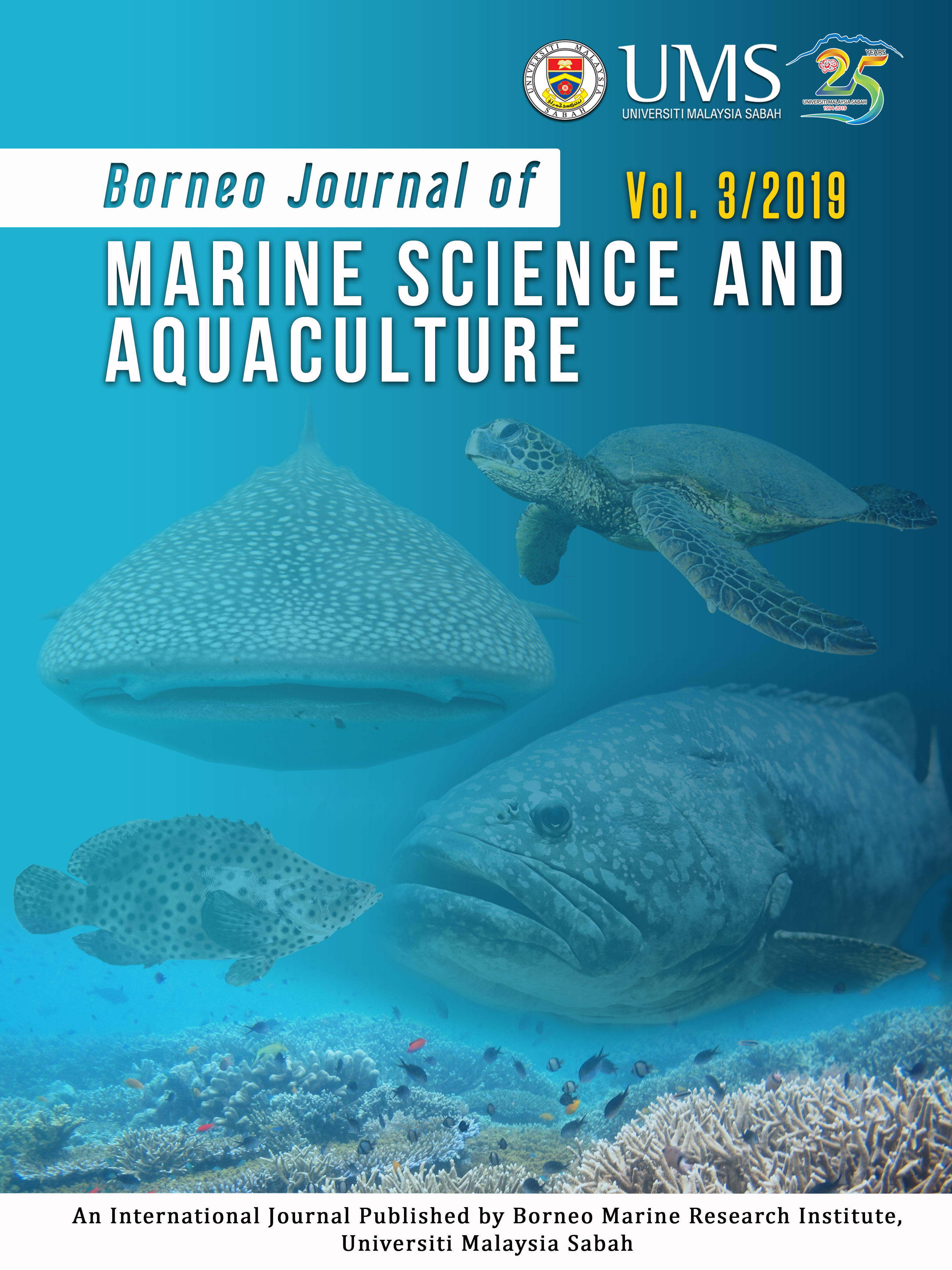Malaysian herbs as feeding attractants and enhancers for the giant freshwater prawn (Macrobrachium rosenbergii) and the whiteleg shrimp (Litopenaeus vannamei)
DOI:
https://doi.org/10.51200/bjomsa.v3i2.1793Keywords:
Herbs, Peppermint, Ginger, Feeding enhancer, Feeding attractantAbstract
Feeding attractiveness of 21 fresh herbs was examined for the giant freshwater prawn (Macrobrachium rosenbergii) and the whiteleg shrimp (Litopenaeus vannamei) at different growth stages in tanks. The feeding attractant and enhancement were assessed by behavioural observations of the test animals in response to pelleted feeds incorporated with the herbal extracts in different concentrations. For M. rosenbergii, peppermint (Mentha piperita) and dokudami (Houttuynia cordata) were the most attractive herbs at all stages, and garlic (Allium sativum) strongly attracting to the juveniles but only weekly to the adults, postlarvae and larvae. Peppermint significantly enhanced feeding of M. rosenbergii at all stages except for the larvae. Garlic was a significant feeding enhancer for M. rosenbergii juveniles and postlarvae. The inclusion of the herbal extract at high concentrations had a negative effect on the feeding. As far as L. vannamei is concerned, the red chilli (Capsicum annuum) was the best feeding attractant and ginger (Zingiber officinale) and peppermint were moderate attractants for adults and juveniles. While galangal (Alpinia galangal), ginger and yellow onion (Allium cepa sp.) enhanced feeding in L. vannamei adults, but red chilli, garlic and peppermint did not enhance feeding. Evidently, the strong feeding attractants were not necessarily effective feeding enhancers. The incorporation of several herb extracts at higher concentrations caused a negative effect on the feeding of the test animals. This could be due to the presence of feeding deterrents in the herb such as saponins which are known to lower food palatability in insect, decapod crustaceans and fishes. More long-term work is warranted to determine if inclusion of feeding enhancing herbs in artificial feed promotes growth performance of the shrimp.
References
Bulfon, C., Volpatti, D. & Galeotti, M. (2015). Current research on the use of plant-derived products in farmed fish. Aquaculture Research 46, 513−551.
Bureau, D.P., Harris, A.M. & Cho, C.Y. (1998). The effects of purified alcohol extracts from soy products on feed intake and growth of Chinook salmon (Oncorhynchus tshawytscha) and rainbow trout (Oncorhynchus mykiss). Aquaculture 161, 27−43.
Chen, J.C., Chen, K.W. & Chen, J.M. (1996). Effect of saponin on survival, growth, molting, and feeding of Penaeus japonicus juveniles. Aquaculture 144, 165−175.
Citarasu, T. (2010). Herbal biomedicines: a new opportunity for aquaculture industry. Aquaculture International 18, 403−414.
Citarasu, T., Sekar, R.R., Babu, M.M., et al. (2002). Developing Artemia enriched herbal diet for producing quality larvae in Penaeus monodon. Asian Fisheries Science 15, 21–32.
Corea, G., Fattorusso, E., Lanzotti, V., et al. (2005). Antispasmodic saponins from bulbs of red onion, Allium cepa L.Var. Tropea. Journal of Agricultural and Food Chemistry 53, 935−940.
Cristea, V., Antache, A., Grecu, I., et al. (2012). The use of phytobiotics in aquaculture. Lucrări Ştiințifica - Seria Zootehnie 57, 250−255.
Cruz-Lacierda, E.R. (1993). Effect of rotenone and saponin on the shell quality of juvenile tiger shrimp, Penaeus monodon. The Israeli Journal of Aquaculture-Bamidgeh 25, 126−130.
De Santis, G., Maddaluno, C., D’Ambrosio, T., et al. (2016). Characterisation of quinoa (Chenopodium quinoa Willd.) accession for the saponin content in Mediterranean environment. Italian Journal of Agronomy 11, 277−281.
Desig, N., Giurfa, M., Lachnit, H., et al. (2006
). Neural representation of olfactory mixtures in the honeybee antennal lobe. European Journal of Neuroscience 24, 1161−1174.
Duchamp-Viret, P., Duchamp, A. & Chaput, M.A. (2003). Single olfactory sensory neurons simultaneously integrate the compound of an odour mixture. European Journal of Neuroscience 18, 2690−2691.
Floreto, E.A.T., Bayer, R.C. & Brown, P.B. (2000). The effect of soy-based diet, with and without amino acid supplementation, on growth and biochemical composition of juvenile America lobster, Homarus americanus. Aquaculture 189, 211−238.
Geyter, E.D., Lambert, F., Greelen, D., et al. (2007). Novel advances with plant saponin as natural insecticides to control pest insects. Pest Technology 1, 97−105.
Golawska, S. (2007). Deterrence and toxicity of plant saponins for the pea aphid Acyrthosiphon pisum Harris. Journal of Chemical Ecology 33, 1598−1606.
Günter-Jordanland, K., Dawidi, C., Dietz, M., et al. (2016). Key phytochemicals contributing to the bitter off-taste of oat (Avena sativa L.). Journal of Agriculture and Food Chemistry 64, 9639−9652.
Harikrishnnan, R., Balasundaram, C. & Heo, M.S. (2011). Impact of plant products on innate and adaptive immune system of culture finfish and shellfish. Aquaculture 317, 1−15.
Hisao, T.H. (1969). Chemical basis of host selection and plant resistance in oligophagous insects. Entomologia Experimentalis et Applicata 12, 777−788.
Hozayen, W.G., El-Desouky, M.A., Soliman H.A., et al. (2016). Antiosteoporotic effect of Petroselinum crispum, Ocimum basilicum and Cichorium intybus L. in glucocorticoid-induced osteoporosis in rats. BMC Complementary and Alternative Medicine 16, 165−176.
Jiang, X., Hansen, H.C.B., Strobel, B.W., et al. (2018). What is the aquatic toxicity of saponin-rich plant extracts used as biopesticides? Environmental Pollution 236, 416−424.
Juntachote, T., Berghofer, E., Bauer, F., et al. (2006). The application of response surface methodology to the production of phenolic extracts of lemon grass, galangal, holy basil and
rosemary. International Journal of Food Science and Technology 41, 121−133.
Kavitha, K., Sangeetha, K.S.S., Sujatha, K., et al. (2014). Phytochemical and Pharmacological profile of Justica gendarussa Burm f.−review. Journal of Pharmacy Research 8, 990−997.
Kawamura, G., Bagarinao, U.B., Senimann, N.S., et al. (2018). Comparative morphology and function of feeding appendages in food intake behaviour of the whiteleg shrimp, Litopenaeus vannamei, and the giant freshwater prawn, Macrobrachium rosenbergii. Borneo Journal of Marine Science and Aquaculture 2, 26−39.
Kawamura, G., Bagarinao, U.B. & Yong, A.S.K. (2017). Sensory systems and feeding behaviour of the giant freshwater prawn, Macrobrachium rosenbergii, and the marine whiteleg shrimp, Litopenaeus vannamei. Borneo Journal of Marine Science and Aquaculture 1, 80−91.
Kawamura, G. Yacoob, S.Y. & Anraku, K. (2001). The gustatory response of the Nile tilapia (Oreochromis niloticus) to saponin. UPV Journal of Natural Sciences 6, 106−110.
Khairul-Bariyah, S., Ahmed, D. & Ikram, M. (2012). Ocimum basilicum: A review on phytochemical and pharmacological studies. Pakistan Journal of Chemistry 2, 78−85.






